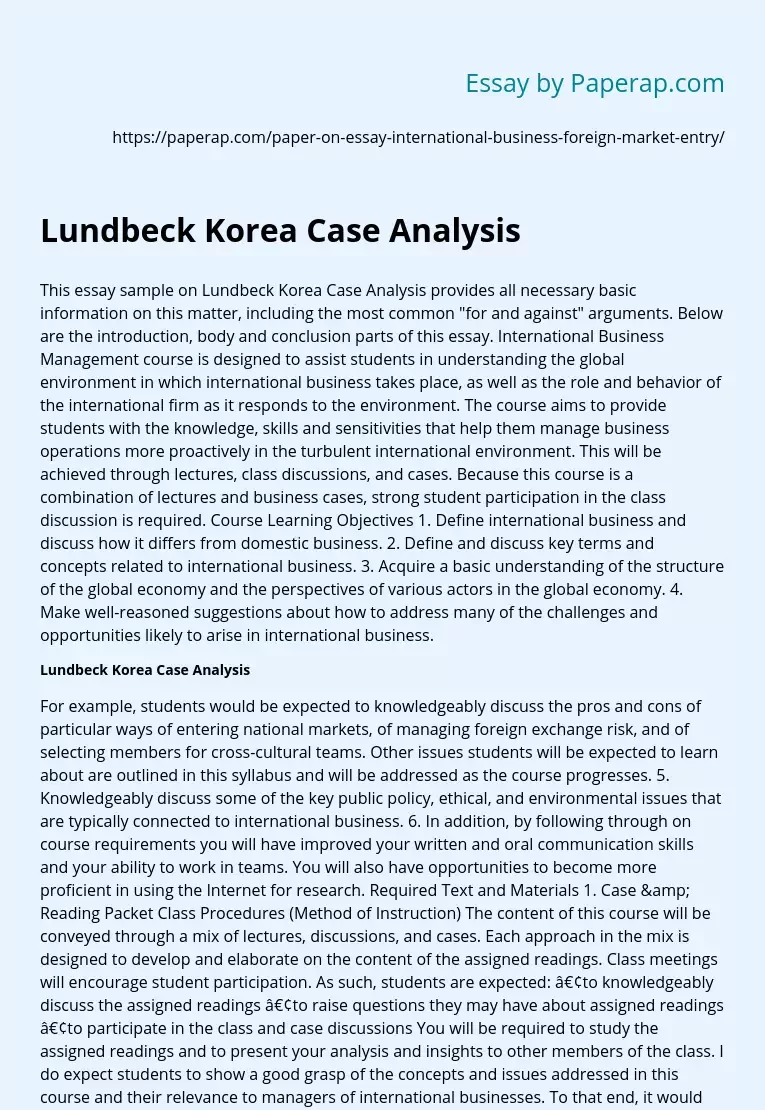Global Environment and the Behavior of an International Firm
This essay sample on Lundbeck Korea Case Analysis provides all necessary basic information on this matter, including the most common “for and against” arguments. Below are the introduction, body and conclusion parts of this essay.
International Business Management course is designed to assist students in understanding the global environment in which international business takes place, as well as the role and behavior of the international firm as it responds to the environment. The course aims to provide students with the knowledge, skills and sensitivities that help them manage business operations more proactively in the turbulent international environment.
This will be achieved through lectures, class discussions, and cases.
Because this course is a combination of lectures and business cases, strong student participation in the class discussion is required. Course Learning Objectives 1. Define international business and discuss how it differs from domestic business. 2. Define and discuss key terms and concepts related to international business.
3. Acquire a basic understanding of the structure of the global economy and the perspectives of various actors in the global economy.
4. Make well-reasoned suggestions about how to address many of the challenges and opportunities likely to arise in international business.
Lundbeck Korea Case Analysis
For example, students would be expected to knowledgeably discuss the pros and cons of particular ways of entering national markets, of managing foreign exchange risk, and of selecting members for cross-cultural teams. Other issues students will be expected to learn about are outlined in this syllabus and will be addressed as the course progresses. 5. Knowledgeably discuss some of the key public policy, ethical, and environmental issues that are typically connected to international business. 6.
In addition, by following through on course requirements you will have improved your written and oral communication skills and your ability to work in teams. You will also have opportunities to become more proficient in using the Internet for research. Required Text and Materials 1. Case & Reading Packet Class Procedures (Method of Instruction) The content of this course will be conveyed through a mix of lectures, discussions, and cases. Each approach in the mix is designed to develop and elaborate on the content of the assigned readings.
Class meetings will encourage student participation. As such, students are expected: •to knowledgeably discuss the assigned readings •to raise questions they may have about assigned readings •to participate in the class and case discussions You will be required to study the assigned readings and to present your analysis and insights to other members of the class. I do expect students to show a good grasp of the concepts and issues addressed in this course and their relevance to managers of international businesses.
To that end, it would be advisable to take notes in class, but, in your reading and in the lectures and discussions try to concentrate on issues, trends and relationships rather than on memorizing definitions and statistics. Evaluation Students are expected to attend classes regularly since constant attendance offers the best opportunity to master the course material and contribute to classroom discussions. Any student who misses a class is responsible for obtaining notes from a classmate regarding any changes in assignment, exam dates, and materials covered in class discussion.
Grading breakdown is as follows: 1. Mid-term Exam 25 % 2. Final Exam 30 % 3. Case presentation (in teams) 30 % 4. Quiz 15 % Total100% Case Analysis for Group Presentation Because international management is a multidimensional challenge, we will make extensive use of case studies during the course. Each case will be presented by a team that consists of 4 to 6 members. The team presentation will be 40 minutes in length and every member in the team should participate in the presentation.
Before presentation, the team has to submit PowerPoint slides on the case it analyzed and presented. Many of you may not be familiar with case analysis, so the following comments are offered as a guide. ? Identify the problem: identify a particular challenge presented in the case and address your comments to a particular problem. This is an important step. The value of the remainder of your analysis hinges on identifying an important problem. 2. Offer solutions to the problem: draw from the case a set of feasible solutions. This step helps to limit your analysis to a finite set of choices.
Develop criteria for solving the problem: from the case material, state your approach to solving the problem. What are the relevant considerations? How do you choose among the alternative solutions? This step allows you to demonstrate your ability to critically analyze the solution. Apply the criteria to the offered solutions: in a straightforward manner, develop a ranking of the offered solutions. Make your recommendation: your ranking will reveal a first best solution. State what conditions your solution depends on, and perhaps offer comments as to how this solution can be implemented.
Case Presentation Grading: case presentations and written reports will be graded on a 100-point scale. More points will be given to case analyses that demonstrated an understanding of a fundamental challenge in the case, and present a persuasive argument for your proposed solution. Closing Note: The timetable and any other sections of this syllabus are subject to change and improvement as the course unfolds.
Global Environment and the Behavior of an International Firm. (2019, Dec 06). Retrieved from https://paperap.com/paper-on-essay-international-business-foreign-market-entry/

